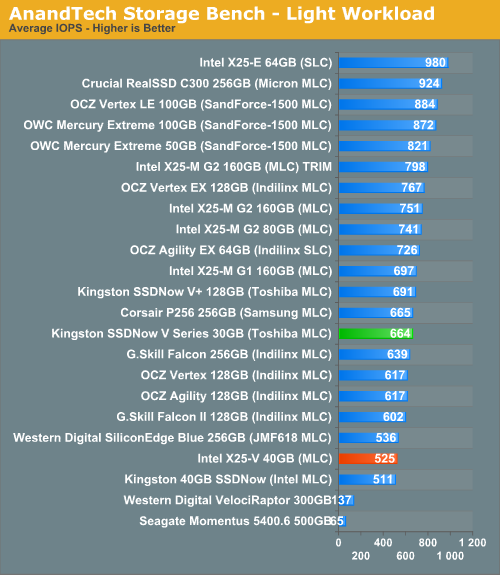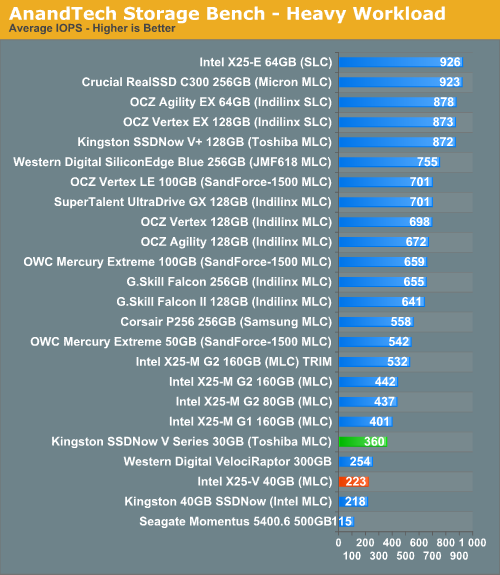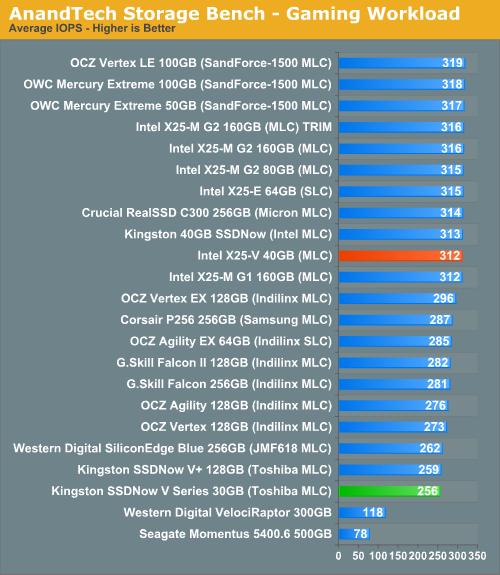Intel's X25-V & Kingston's 30GB SSDNow V Series: Battle of the $125 SSDs
by Anand Lal Shimpi on March 19, 2010 12:00 AM EST- Posted in
- Storage
AnandTech Storage Bench
Note that our 6Gbps controller driver isn't supported by our custom storage bench here, so the C300 results are only offered in 3Gbps mode.
The first in our benchmark suite is a light usage case. The Windows 7 system is loaded with Firefox, Office 2007 and Adobe Reader among other applications. With Firefox we browse web pages like Facebook, AnandTech, Digg and other sites. Outlook is also running and we use it to check emails, create and send a message with a PDF attachment. Adobe Reader is used to view some PDFs. Excel 2007 is used to create a spreadsheet, graphs and save the document. The same goes for Word 2007. We open and step through a presentation in PowerPoint 2007 received as an email attachment before saving it to the desktop. Finally we watch a bit of a Firefly episode in Windows Media Player 11.
There’s some level of multitasking going on here but it’s not unreasonable by any means. Generally the application tasks proceed linearly, with the exception of things like web browsing which may happen in between one of the other tasks.
The recording is played back on all of our drives here today. Remember that we’re isolating disk performance, all we’re doing is playing back every single disk access that happened in that ~5 minute period of usage. The light workload is composed of 37,501 reads and 20,268 writes. Over 30% of the IOs are 4KB, 11% are 16KB, 22% are 32KB and approximately 13% are 64KB in size. Less than 30% of the operations are absolutely sequential in nature. Average queue depth is 6.09 IOs.
The performance results are reported in average I/O Operations per Second (IOPS):

Intel's X25-V performs virtually identically to the older Kingston 40GB Boot Drive. The new 30GB drive does have the advantage though, performing much more like an Indilinx drive than a scaled down X25-M thanks to its higher sequential write speed.
If there’s a light usage case there’s bound to be a heavy one. In this test we have Microsoft Security Essentials running in the background with real time virus scanning enabled. We also perform a quick scan in the middle of the test. Firefox, Outlook, Excel, Word and Powerpoint are all used the same as they were in the light test. We add Photoshop CS4 to the mix, opening a bunch of 12MP images, editing them, then saving them as highly compressed JPGs for web publishing. Windows 7’s picture viewer is used to view a bunch of pictures on the hard drive. We use 7-zip to create and extract .7z archives. Downloading is also prominently featured in our heavy test; we download large files from the Internet during portions of the benchmark, as well as use uTorrent to grab a couple of torrents. Some of the applications in use are installed during the benchmark, Windows updates are also installed. Towards the end of the test we launch World of Warcraft, play for a few minutes, then delete the folder. This test also takes into account all of the disk accesses that happen while the OS is booting.
The benchmark is 22 minutes long and it consists of 128,895 read operations and 72,411 write operations. Roughly 44% of all IOs were sequential. Approximately 30% of all accesses were 4KB in size, 12% were 16KB in size, 14% were 32KB and 20% were 64KB. Average queue depth was 3.59.

Crank up the sequential writes and Kingston's lead grows. The 30GB V series drive almost performs like an X25-M G1 in this case. The X25-V on the other hand performs more like a low latency VelociRaptor. Still better than a hard drive, but don't expect to copy files any faster.
The gaming workload is made up of 75,206 read operations and only 4,592 write operations. Only 20% of the accesses are 4KB in size, nearly 40% are 64KB and 20% are 32KB. A whopping 69% of the IOs are sequential, meaning this is predominantly a sequential read benchmark. The average queue depth is 7.76 IOs.

With both Intel and Kingston equal in sequential read performance, the differentiating factor here is strictly random read performance where the X25-V has the edge.










78 Comments
View All Comments
Anand Lal Shimpi - Friday, March 19, 2010 - link
No, unfortunately it looks like the bracket keeps the drive centered, which positions the SATA connectors too far to the middle to work properly in 3.5" carriers like what Apple uses for the Mac Pro.Take care,
Anand
Drakino - Friday, March 19, 2010 - link
Thanks for the response. If you can pass some feedback to the manufacturers, can you let them know this is one of the big reasons I haven't jumped on a SSD yet? A SATA compliant 3.5 inch solution would be appreciated by those of us using cableless drive setups. I know HP shipped a few VoodooPC gaming rigs with similar drive bays.I'm still really tempted to pick one of these up, but not sure how I can get it in my system without just dangling the drive on the connector.
Nomgle - Wednesday, March 24, 2010 - link
See below - Icy Dock make two adaptors that'll fit your Mac Pro just fine :)vol7ron - Friday, March 19, 2010 - link
Anand,Though I'm still operating almost all my machines on XP, I thought you said you were going to start doing all your benchmarks in Win7.
I appreciate doing both in this example, but that's got to be a lot of time spent doing it on multiple machines.
vol7ron
PS
This article really interests me when thinking about building an HTPC. I know I'll need a lot of storage space - I hope to have 4TB worth - but having a quick, speedy, small drive would be a loading dream. Thanks for the review.
Itomerou - Friday, March 19, 2010 - link
I really enjoyed the article and am always impressed with the level of detail that is done when testing and comparing components. However, the only problem with this article is that when comparing queue depth and light/heavy workload averaging the results provides no value in so far as the distribution of IOPS is not normally distributed. Additionally, the fact that these drives are completely different in their drivers and priority addressing of queue requests to say that one drive is able to server requests faster depends on the fact that measurement of requests served fits the drives exact distribution of requests served. This is apparent with the charts of how each drive performs for sequential and random access. Finally, in order to make substantial claims confidence intervals must also be constructed otherwise how accurate are the results?On the otherhand I am still intrigued with the findings.
Zelog - Friday, March 19, 2010 - link
Look at the size of the kingston, it's tiny! Now you don't even need dedicated 2.5" space for the drive, making the htpc/laptop/net book even smaller. It is definitely worth its price in the right settings.GeorgeH - Friday, March 19, 2010 - link
That was my first thought, but with a slightly different angle. If Kingston made a custom form factor you could extend laptops with dual storage below ~15". In something like the M11x you could have one of these as a fast boot drive while using a big and slow HDD with aggressive power management to get more storage, faster storage, and longer battery life.(Yes, I'm aware of mini-PCIe (and other custom connection) SSDs for netbooks and other SFF devices, but the performance there is terrible.)
Shadowmaster625 - Friday, March 19, 2010 - link
Entry level is not $125. $125 is not "cheap" or "inexpensive".davepermen - Friday, March 19, 2010 - link
it's a cheap and inexpensive SSD, and definitely the most entry level ssd existing.and yeah, if you buy an entry level desktop (not an atom), you easily pay several 100$. investing 100 more to make it perform 'really fast', is the most cheap and inexpensive way to make it perform much better.
how would YOU invest that amount of money to boost up your pc? (laptops are a different story because there storage matters actually, in a pc, just let the old hdd be plugged in too)
casteve - Friday, March 19, 2010 - link
The OCZ 30GB Agility @ $119 wins the entry level contest over these two. $99 after MIR at newegg.